Margao
| Margao मडगांव Madgaon | |
|---|---|
| City | |
|
Margão City Square | |
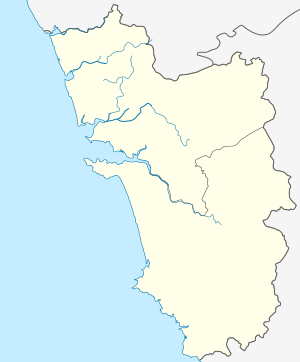 Margao  Margao Location of Margão in Goa | |
| Coordinates: 15°16′25″N 73°57′29″E / 15.27361°N 73.95806°ECoordinates: 15°16′25″N 73°57′29″E / 15.27361°N 73.95806°E | |
| Country |
|
| State | Goa |
| District | South Goa |
| Sub-district | Salcete |
| Government | |
| • Chairperson | Dr. Babita Prabhudesai[1] |
| • Vice-chairperson | Dorris Texeira[1] |
| Area | |
| • City | 15.10 km2 (5.83 sq mi) |
| • Metro | 22.1 km2 (8.5 sq mi) |
| Elevation | 10 m (30 ft) |
| Population (2011) | |
| • City | 87,650 [2] |
| • Metro | 106,484 [2] |
| Demonym(s) | Madgaonkar (मडगांवकार) |
| Time zone | IST (UTC+5:30) |
| PIN | 403601/2 |
| Telephone code | 0832 |
| Vehicle registration | GA-02-, GA-08- |
| Website | MMCMargao.gov.in |
Margao (pronounced [mɔɽɡãːw]) is the second largest city by population, and the commercial and cultural capital of the Indian state of Goa. It is the administrative headquarters of Salcete taluka and South Goa district. By road, Margao is located approximately 33 kilometres (21 mi) from the capital Panaji, and 27 kilometres (17 mi) from Vasco da Gama.
Etymology
Margão is the Portuguese spelling with Madugão being used in Konkani. It is known as Madgaon in Marathi. It is derived from the Sanskrit Maṭhagrām which means a village with a matha. The oldest math of India, the Kavale math was here which was destroyed by portuguese. Kavele math Gaudapadacharya swamiji inspired Sankaracharya to travel to north and rejuvenate Hinduism.
In Ravanphond now a suburb of Margao there are shrines of Matsyendranath and Gorakhnath.[3] The abode of Nath medicants was called a Matha(Monastery). Madagao was called Mathagrama on account of Vaishnavite Math belonging to Dvaita sect which was founded in the latter 15th century and shifted to Partagali after the establishment of the Portuguese power.[4]
History

Margao in pre-Portuguese times was one of the important settlements in Salcete and known as Matha Grama (the village of Mathas) as it was a temple town with nine Mathas in temple schools. Its replacement in 1579 was destroyed by raiders along with the seminary that had been built alongside it. The present church was built in 1675.[5][6]
The initial settlement of Margao grew from the site of the ancient Damodar Temple. The original temple was demolished and the temple tank was filled up to be replaced by the Holy Spirit church and church grounds. The deity Damodar (a form of Lord Shiva) was carried across the Zuari Agranashini river to the Novas Conquistas in which the Sonde rulers resided. While the western side of the Holy Spirit Church developed as a market place, the settlement grew on the eastern side, that is, the Borda region, with the church at its core and extended outwards.
The Holy Spirit Church main square is defined on one side by the church with its baroque architecture and the parochial house, and on the other side by the palatial mansions of affluent elite Catholics, positioned in a row. The Associação das Communidades (Communities Association) building and the school being the odd exceptions which add to its character and sense of scale. They have a maximum height of two stories, and balcões balconies and varandas (verandas) facing the square. Parallel to the church square is the commercial street (old market). There is also a landscaped area next to the church called Praça da Alegria (Joy Square). The church feast is celebrated before the monsoons, it is a time when many residents make pre-monsoon purchases to stock up for a prolonged rainy season.
Margao's importance as an administrative and commercial area grew with the increasing dependence of the surrounding towns and villages; leading to the administrative centre with the town hall at its centre being built in the south. The commercial market became attached to it and was hence called maud-gao or the market town of Goa, and since then the town has grown towards the east.
In 1961, Goa was incorporated into the Indian Union, and Margao was declared as the administrative center of the district of South Goa.
Geography
Margao is located at 15°16′25″N 73°57′29″E / 15.27361°N 73.95806°E and has an average elevation of 10 metres (33 ft).[7]
Nestled on the banks of the River Sal, Margao is amongst the oldest recorded towns in Goa. Portuguese style mansions dot its landscape. One of the fastest growing cities in Goa, its fast growing suburbs include Aquem, Fatorda, Gogol, Borda, Comba, Navelim and Davorlim.
Climate
Margao features a tropical monsoon climate. The climate in Margao is hot in summer and equable in winter. During summers (from March to May) the temperature reaches up to 32 °C and in winters (from December to February) it is usually between 28 °C and 20 °C. The monsoon period is from June to September with heavy rainfall and gusty winds. The annual average rainfall is 2881 mm (113.5 inches).
| Climate data for Margao | |||||||||||||
|---|---|---|---|---|---|---|---|---|---|---|---|---|---|
| Month | Jan | Feb | Mar | Apr | May | Jun | Jul | Aug | Sep | Oct | Nov | Dec | Year |
| Average high °C (°F) | 31.9 (89.4) |
31.7 (89.1) |
32.1 (89.8) |
33.0 (91.4) |
33.3 (91.9) |
30.4 (86.7) |
29.0 (84.2) |
28.8 (83.8) |
29.7 (85.5) |
31.7 (89.1) |
32.9 (91.2) |
32.6 (90.7) |
31.43 (88.57) |
| Average low °C (°F) | 19.8 (67.6) |
20.6 (69.1) |
23.2 (73.8) |
25.5 (77.9) |
26.4 (79.5) |
24.7 (76.5) |
24.3 (75.7) |
24.0 (75.2) |
23.9 (75) |
23.8 (74.8) |
22.2 (72) |
20.9 (69.6) |
23.28 (73.89) |
| Average precipitation mm (inches) | 0 (0) |
0.1 (0.004) |
0.6 (0.024) |
7.2 (0.283) |
97.1 (3.823) |
861.5 (33.917) |
899.8 (35.425) |
591.6 (23.291) |
256.3 (10.091) |
116.5 (4.587) |
33.9 (1.335) |
16.2 (0.638) |
2,880.8 (113.418) |
| Source: IMD | |||||||||||||
Demographics
As of the 2011 census of India,[8] Margão had a population of 87,650.[2] Males constituted 51% of the population and females 49%. It had an average literacy rate of 90%; male literacy was 93%, and female literacy 86.8%. In Margão, 9.8% of the population was under 7 years of age.With a population of 106,484 in the metropolitan area, Margao is second largest Urban agglomeration in Goa.[2]
Education
Margao hosts many schools and colleges. Loyola High School (Goa) near the Old Bus Stand is a Jesuit-run school and is one of the oldest in Margao. The Bhatikar Model English High School, popularly known after its founder Late Pandurang Raya Bhatikar,[9] was established in the year 1935[10] and is one of the leading educational institutions in the state of Goa. Mahila & Nutan High School, established as Samaj Seva Sangh’s Mahila Vidyalay for girls in 1933, is now a co-ed school since June 1972.[11] Manovikas High School, now located in Sonsodo, is one of the premier ICSE schools in Goa.[12] The other educational institutes in Margao include St. Joseph High School[13] at Aquem, Holy Spirit Institute,[14] Presentation Convent (for girls),[14] Fatima Convent (for girls),[14] and Perpetual Convent High School located in Navelim. Most schools function in accordance with the curriculum prescribed by the Directorate of Education, Goa, and the Goa Board of Secondary and Higher Secondary Education, Goa.
The colleges in Margao include The Parvatibai Chowgule College which was housed in Portuguese Military Barracks opposite Multipurpose High School at a place called Vidyanagar. The then Principal was Dr. Wagh who was later appointed the Director of Post Graduate Center of Bombay University, situated in Sushila Building, 18 June Road, Panaji. This college was shifted to the present location in 1972 and the Principal then was Prof P. S. Rege. The Buildings were inclined in shape narrower at the base and broader at the top and it was a kind of attraction of architecture which has undergone a change and modified later on. The Parvatibai Chowgule College, Shree Damodar College of Commerce and Economics, Shree Damodar Higher Secondary School Of Science and R.M.S Higher Secondary School. There are also ITIs (Industrial Training Institutes) which impart technical education. Among professional colleges Don Bosco College of Engineering located at Fatorda and Govind Ramnath Kare College of Law offer degree courses in Engineering and Law respectively.
Transport
Air
The nearest airport to Margao is Dabolim Airport which is 23 km away from it.[15]
Rail

Madgaon railway station is Goa's biggest and busiest as it is a railway junction positioned at the intersection of the Konkan Railway and the South Western Railway. All trains stop at Margao. Hence it is used more commonly as a transit stop rather than a tourist destination by many people who either head off down south to Palolem (38 km) or to Benaulim and Colva which are about six kilometers away and are popular tourist destinations.
Margao hosted the test track for the Skybus Metro project,[16] an elevated rail system patented by the Konkan Railway Corporation,[17] which was scrapped due to an accident which occurred during the test drive killing one engineer and seriously injuring a crew of three.[18] However, Mr B Rajaram who had invented the rail system has stated that in his opinion, the accident was avoidable.[19]
Road
Margao is connected by road to other cities like Mangalore, Udupi, Bhatkal, Kumta, Karwar, Ratnagiri, and Mumbai through the National Highway 17 (NH17). Also, there is road which connects Margao to Ponda and other towns of Goa state.
Language
Konkani is the most widely spoken language in Margao. Portuguese is still spoken and understood by a small number of people. English and Hindi are also spoken and understood by the town's population. The dialect of Konkani in South Goa is different from that spoken in North Goa. Kannada is also spoken in a significant level. Most of the flower and vegetable merchants converse in Kannada.
Tourism
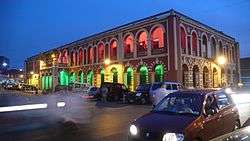
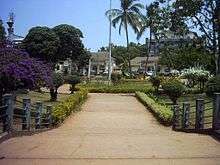
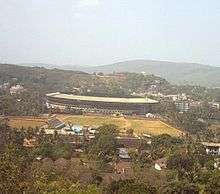

The town has many sights and destinations. These include the 'Closed' Market called, in the Portuguese language, Mercado de Afonso de Albuquerque or in Konkani as "Pimplapedd" or "Pimpalakatta," the municipal building (Câmara Municipal), the municipal garden, Anna Fonte (natural springs), Old Market or Mercado Velho, Holy Spirit Church, grand colonial mansions (especially the Seven Gables House near the church), the chapel at Monte Hill, the Hindu crematorium or 'Smashan' and the Muslim burial ground or 'Kabrasthan' both situated on Pajifond's Rua das Saudades.
Some of the town suburbs include Pajifond, Aquem, Gogol, Borda, Malbhat, Kharebandh, Old Market, Navelim and Comba, the last two being the oldest parts of the town.
There are a number of churches and temples in Margao, since the population is predominantly Hindu with a significant Roman Catholic and a very small Muslim minority. The famous churches in Margao are the Holy Spirit Church, the Grace Church, The St Sebastian Church in Aquem (The Old St. Sebastian Chapel, popularly known as the Pandava Copel still stands next to the modern St. Sebastian Church) and the Monte Hill Chapel, the famous temples are the 'Damodar Temple' (Saal), the 'Hari Mandir', the 'Maruti Mandir' at Davorlim the 'Saibaba Temple' at Davorlim, the 'Shiv Temple' (Ling) at Fatorda near Nehru Stadium (which is the original Temple of Damudora). There are 2 mosques in Margao, One in the Malbhat area and one on the Monte hill. Presently, since 2004, there are twenty-four new mosques in Margao. There is also a Jain temple at Pajifond.
Landmarks
The Margao Town Hall is situated in the heart of the town. Opposite to the town hall is the Margao Municipal Garden. The northern segment of the Margao municipal garden was developed by the Mavany family and is named after King Aga Khan who visited Goa just before its liberation. The entire garden is now municipal property and is maintained by the Margao Municipal Council. The Narcinva D. Naik residence, also known locally as Damodar Sal, played host to Swami Vivekananda during his visit to Goa in October 1892.[20] The mansion also houses Margao's well-known temple-hall "Dambaba Saal".
Culture
The town is also claimed as the cultural capital of Goa. A cultural center named 'Ravindra Bhavan' was inaugurated by the then Chief Minister of Goa, Digambar Kamat in July 2008 at Fatorda which is also an Official Venue For International Film Festival of India . It also has Goa's biggest sports stadium, the Nehru Stadium at Fatorda.[21] The Akhil Bharatiya Marathi Sahitya Sammelan was held in 1964.[22]
Some of the theatres in Margao include the Gomant Vidya Niketan, OSIA Multiplex, Vishant and Lata; in addition to Goa's biggest theater, the Metropole. Inox has recently launched a multiplex with a capacity of 904 seats.The Gomat Vidya Niketan is a premier centre for arts in the town.
People from all over Goa congregate at the special market to buy spices and dried fish to be used during the oncoming rainy season.
The usual specialities that are found in the cuisine of Goa are also to be found in Margao. The curry of Margao is a praised local speciality. Cans of curry of Margao are currently exported to Portugal and elsewhere.
Margão is also the name of a brand of spices sold in Portugal.
Gallery
- Life in Margao
-
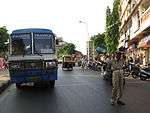
Margao Crossing Guard
-

Margao City Hall
-

Rickshaw Stand
-
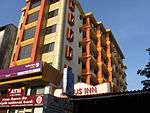
Modern Margao
-
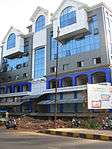
New buildings under construction
-

Vendor at Margao Fish Market
-
Old and new St. Sebastian Church in Aquem
-
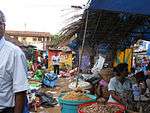
Fish Market
-

Margao Streets
-

Street in Margao
-

Margao Municipal Park
-

Busy Margao Intersection
See also
| Madgaon (MAO) | ||||
| Next 'Small' station towards Mumbai: Majorda |
Konkan Railway : Railway (India) | Next 'Small' station from Mangalore: Balli |
||
| Distance from Mumbai(CST) = 0765 KM | ||||
| Next 'Main' station towards Mumbai: Kudal |
Konkan Railway : Railway (India) | Next 'Main' station from Mangalore Karwar | ||
References
- 1 2 http://www.heraldgoa.in/Goa/Babita-Dorris-elected-unopposed-in-Margao/95346.html
- 1 2 3 4 http://www.census2011.co.in/census/metropolitan/415-margao.html
- ↑ Satoskar, B.D (1979). Gomantak: prakṛitī āṇi saṃskṛitī. Śubhdā-Sārasvat. p. 113.
- ↑ Mitragotri, Vithal Raghavendra (1999). A socio-cultural history of Goa from the Bhojas to the Vijayanagara. Institute Menezes Braganza. pp. 151–152.
- ↑ "Hindu temples and deities" by Rui Gomes Pereira
- ↑ "Gomantak Prakruti ani Sanskruti" by B.D.Satoskar
- ↑ Falling Rain Genomics, Inc – Margao. Fallingrain.com. Retrieved on 2012-04-27
- ↑ "Provisional Population Totals Paper 2, Volume 2 of 2011: Goa State Tables" (PDF). censusindia.gov.in. Registrar General and Census Commissioner of India. Retrieved 9 July 2013.
- ↑ BHATIKAR MODEL HIGH SCHOOL - education that empowers. Margao, Goa, India Archived 3 May 2014 at the Wayback Machine.
- ↑ BHATIKAR MODEL HIGH SCHOOL - education that empowers. Margao, Goa, India Archived 30 August 2014 at the Wayback Machine.
- ↑ About Us | Mahila & Nutan English High School
- ↑ Welcome to iSchool
- ↑ St Joseph High School, Margao (GOA)
- ↑ "Airports Authority of India". Aai.aero. 2011-09-21. Retrieved 2012-05-09.
- ↑ Skybus page from konkanrailway.com
- ↑ Patent of Skybus from konkanrailway.com
- ↑ Accident details. Hindu.com (2004-12-23). Retrieved on 2012-04-27.
- ↑ ACD article 20 July 2010. Docs.google.com. Retrieved on 2012-04-27.
- ↑ News article from Archived 29 October 2006 at the Wayback Machine.. goacom.com. Retrieved on 2012-04-27.
- ↑ Cricinfo page on Nehru Stadium. Content-usa.cricinfo.com. Retrieved on 2012-04-27.
- ↑ Rediff On The NeT: Kusumagraj dies at 87
External links
| Wikimedia Commons has media related to Margao. |
-
 Margao travel guide from Wikivoyage
Margao travel guide from Wikivoyage - Hospital in Margao – Apollo Hospital
- Tourist information about Margao
- Photographs of the life in Margao
